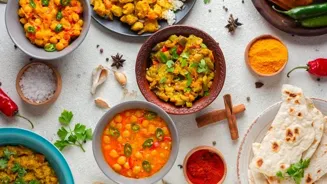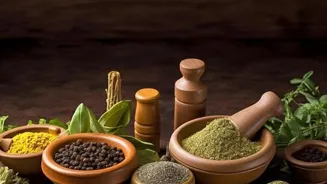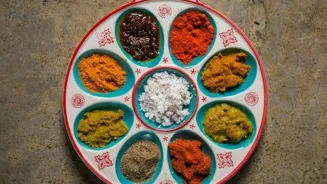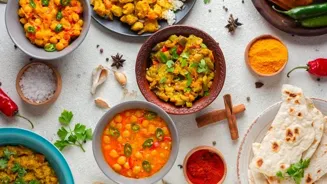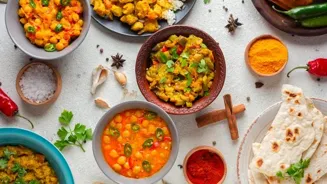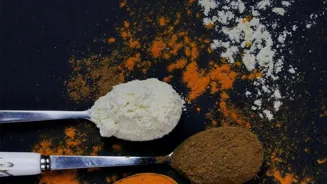Unlock the Secrets of Indian Curries: Spice, Technique, and Flavor - Explore the art of curry-making and elevate your dishes!
For many Indians, a good curry is not just food; it's a memory, a feeling, a connection
to home. Each region boasts its own unique style and set of ingredients, giving us a dazzling array of flavors.
But beyond the long lists you might see in recipes, there are some fundamental secrets that professional cooks and seasoned home chefs use to elevate their curries from good to unforgettable. Understanding these core elements is key to unlocking the true potential of Indian cuisine.
Freshly ground spices elevate curry flavor
One of the most crucial, yet often overlooked, aspects of making a truly delicious curry is the quality of the spices. It all starts with freshness. Pre-ground spices, while convenient, often lose their potency over time.
Buying whole spices and grinding them yourself, even with a simple mortar and pestle or a small spice grinder, makes a world of difference.
Spices add vibrant flavors to dishes, each with unique roles
The aroma and flavor are significantly more vibrant. Secondly, it's important to understand the nuances of each spice. Turmeric lends its earthy flavor and signature yellow color, while cumin adds a warm, smoky note.
Coriander brings a citrusy brightness, and garam masala, of course, provides a complex blend of warmth and spice. Learn to identify the individual flavors and how they work together.
Spice layering in cooking enhances flavor profiles
The order in which you add spices can also greatly affect the final outcome. Whole spices, like cinnamon sticks, cardamom pods, and cloves, are usually tempered in hot oil or ghee at the beginning to release their aromatic oils.
Ground spices are generally added later, after the onions and ginger-garlic paste have been sautéed. This helps to prevent them from burning and losing their flavor. Mastering spice layering will transform your curry preparations. Consider making your own spice blends at home.
Create custom curry blends by controlling ingredients and proportions to elevate dishes
This not only allows you to control the ingredients and their proportions, but also lets you experiment with different combinations to create your own signature curry blends. You can adjust the level of heat, the amount of sweetness, or the overall fragrance based on your preferences.
A good spice blend, carefully crafted, can elevate even the simplest ingredients.
Indian curry's flavor depends on slow caramelization of onion, ginger, garlic
Beyond spices, the foundation of most Indian curries rests on the holy trinity of onion, ginger, and garlic. These three ingredients, when properly prepared, create a flavor base that is both aromatic and deeply savory.
The key is to sauté them slowly and patiently until they are golden brown and caramelized. This process, known as "bhunno," takes time, but it is essential for developing the richness and depth of flavor that characterizes a well-made curry.
Rushing this step will result in a raw, pungent taste that overpowers the other ingredients. So, be patient and let the onions transform into sweet, golden jewels. Many home cooks are guilty of not doing this, giving raw strong flavour to many curry preparations. Spend time on bhunon and you will instantly improve
Choose fresh veggies, time them right for perfect curry textures
Once the base is ready, the choice of vegetables and other ingredients comes into play. While some curries rely on a single standout vegetable, others feature a medley of flavors and textures.
Whether it's potatoes, cauliflower, spinach, or paneer, the key is to choose fresh, high-quality ingredients and to cook them properly. The secret to perfectly cooked vegetables in a curry is to add them at the right time, depending on their cooking time.
Heartier vegetables, like potatoes and cauliflower, can be added earlier so they have time to soften. While leafy greens, like spinach, should be added towards the end so they don't become mushy.
By paying attention to the doneness of each vegetable, you can create a curry that had varied and delightful textures.
Stock enhances curry flavor over water; veggie stock ideal for richness
The liquid component of a curry is also crucial for flavor. While water is sometimes used, adding stock or broth creates a richer and more complex taste. Vegetable stock, in particular, is a great option for vegetarian curries, as it adds depth and enhances the flavors of the vegetables.
Yogurt and cream enhance flavor and texture of dishes
Another flavour enhancer is yogurt or cream. A touch of yogurt added toward the end of cooking can give a pleasant creaminess and tanginess to the finished dish. Cream works in a similar way, adding richness and a velvety texture. But be careful not to add too much, as it can mask the other flavors.
Remember to whisk yogurt before adding, otherwise, curdling could happen and it is not palatable. Adding yogurt and cream will add nice glossy appearence to any dish- people eat with their eyes before their mouth.
Enhance curry with coriander, lemon, butter for perfect balance
Finally, don't forget the finishing touches. A sprinkle of fresh coriander leaves, a squeeze of lemon juice or a knob of butter can all elevate a curry from good to great. These final touches add brightness, acidity, or richness that balance the flavors and create a truly harmonious dish.
Experiment with garnishes for best Indian curry taste
Experiment with different garnishes and find what works best for your taste. The most important secret to mastering Indian curries is to practice and experiment. Don't be afraid to try new things, to adjust the spice levels, or to substitute ingredients based on what you have on hand.
The more you cook, the better you will become at understanding the flavors and textures of Indian cuisine.
Unlock secret ingredients for authentic Indian curries
So, go ahead, delve into your spice cabinet, gather your ingredients, and start cooking! With a little practice and a willingness to learn, you can unlock the secret ingredients behind your favorite Indian curries and create delicious, authentic dishes that will impress your family and friends.
It can take years to master, but the journey is flavourful and worth it.
Discover the pungent power of asafoetida in cooking
In the world of spices, there also exists “hing” or asafoetida, a pungent spice used carefully. It adds a savoury depth, especially in lentil and vegetable dishes. A pinch is often enough, as its flavor can be strong. Sourcing quality ingredients is beneficial in the long run.
Fresh vegetables and properly stored spices contribute greatly to the overall taste of the curry. Local markets or specialty stores are good places to find high-quality ingredients.
